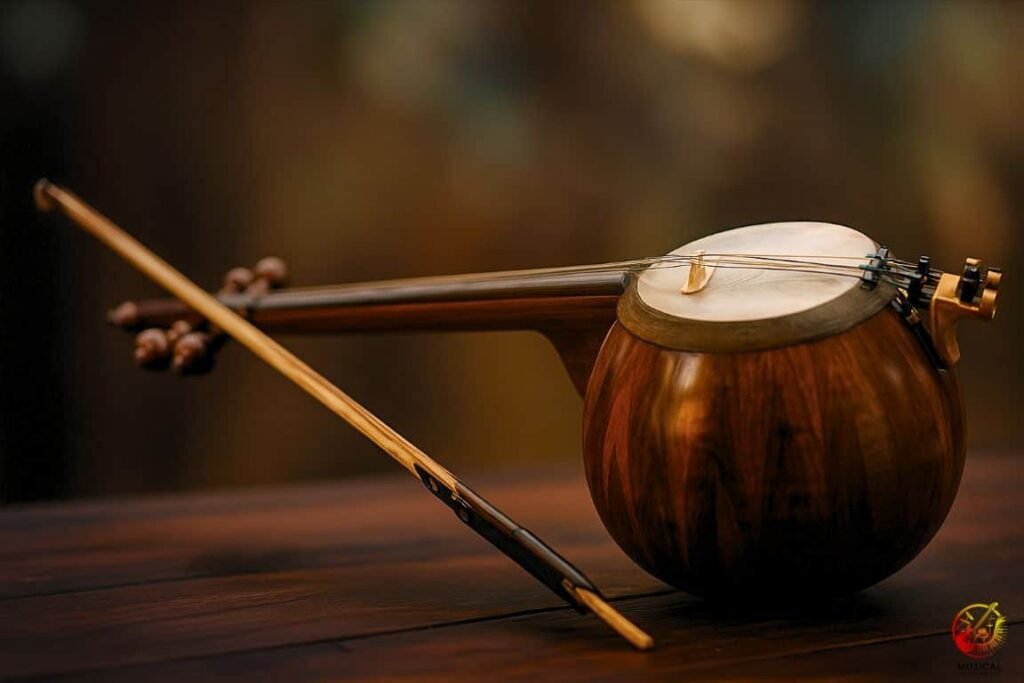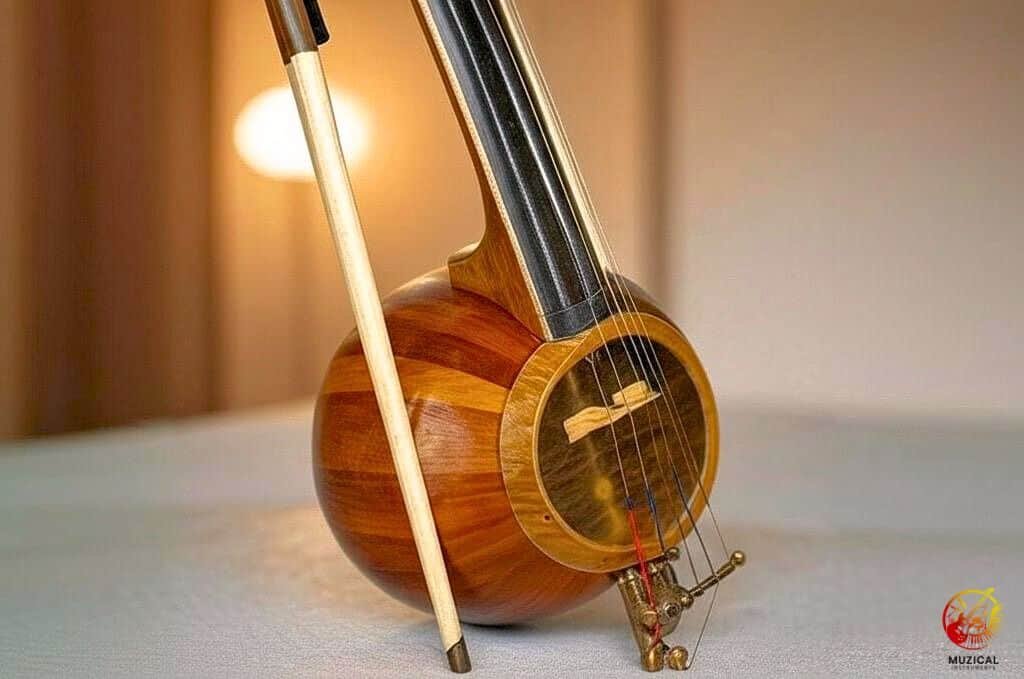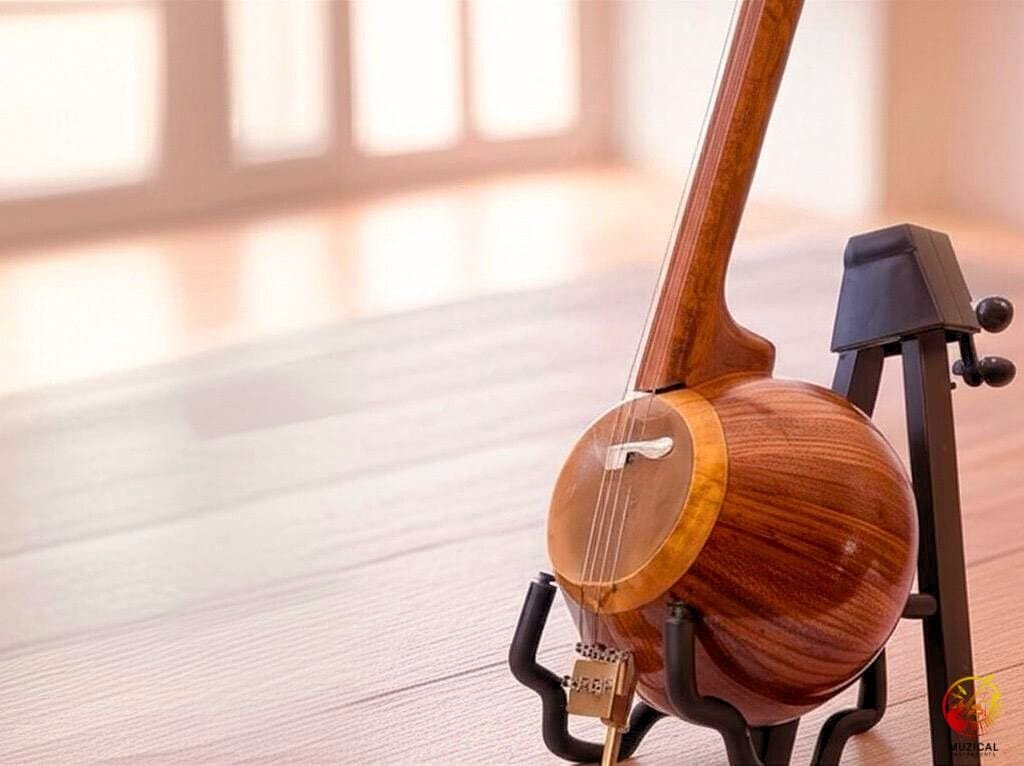Why Is Kamancheh Covered with Skin? The Secret to a Singing Sound
The answer to question: why is Kamancheh covered with skin? is simple, the skin acts as a natural sound filter. This isn’t just a tradition, it’s a clever design that removes harsh, sharp tones, giving the instrument its famously warm and emotional voice.
While it might seem strange to use a soft hide instead of wood, this skin is the secret ingredient that allows the Kamancheh to “sing.”
This article will show you exactly how that works. We’ll look at the science behind the sound, the different types of skin used by a luthier (instrument maker), and why this design makes the Kamancheh so different from a violin.
How Does the Skin Top Change the Instrument’s Voice?

To get the answer to why is Kamancheh covered with skin? you have to think about its top part, the soundboard, in a new way. It’s not just there to make the sound louder; it’s there to shape it.
It’s a Sound Filter
Think of the skin like a special filter on a camera. A filter changes the color and mood of a picture. The Kamancheh’s skin does the same thing for its sound. The raw vibration from the strings and bow travels through the bridge to the skin. The skin is soft and flexible, so it naturally absorbs and muffles the super high, sharp, and sometimes scratchy sounds.
What’s left? The warm, rounded, and rich middle sounds. And that’s the magic. Those middle sounds are in the same range as the human voice. This is why a Kamancheh sounds like it’s singing or crying. It’s a deliberate choice to create a warm, personal, and emotive sound.
A Different Kind of Resonance
Resonance is how something vibrates to make sound. A hard wooden top on a violin is designed to vibrate a lot, making a bright and powerful sound that can fill a huge room. The skin on a Kamancheh has a more controlled resonance. It vibrates just enough to let that warm, vocal quality shine through without getting too loud or sharp. The answer to why is Kamancheh covered with skin is all about controlling this vibration to get a specific timbre, or sound color.
What Kinds of Skin Are Used to Make a Kamancheh?

The instrument maker’s choice of skin is a huge deal. The hide has to be thin, even, and strong enough to handle the pressure from the strings. Over many years, builders in places like Persia (modern-day Iran) and Azerbaijan found a few types that work best.
The most common are lamb, goat, and fish skin. Each one gives the instrument a slightly different personality.
| Skin Type | What It Sounds Like | Good For | Not So Good For |
|---|---|---|---|
| Lambskin | The warmest and softest sound. It’s very round and gentle. | Creating soulful, emotional music like in the Persian Dastgah style. | Music that needs a loud or punchy sound. It can also be sensitive to weather. |
| Goatskin | A bit brighter and clearer than lambskin. It has more punch. | A great all-around choice that works for many styles. It’s also tougher. | It might not sound quite as deep or warm as the best lambskin. |
| Fish Skin | The clearest and sharpest sound of all. It’s very direct. | Cutting through in a band. It’s popular for the clear melodies in Azerbaijani Mugham music. | It can sound a little thin if not matched with the right instrument body. |
A master luthier is like a chef. They look at the Kamancheh’s wooden bowl, often made from mulberry wood, and choose the perfect skin to balance it. If the wood is very bright, they might use a warm lambskin. This careful pairing is key to the instrument’s acoustic properties.
So, Why Is Kamancheh Covered With Skin Instead of Wood Like a Violin?
This is a great question because it’s about different tools for different jobs. Both the Kamancheh and the violin are amazing instruments, but they were created for very different reasons. The violin was made in Europe to be loud and powerful enough for big orchestras in giant concert halls.
The Kamancheh, born along the historic Silk Road, was made for more personal music. Its sound was meant for smaller rooms, where it could express deep feelings and play the subtle notes of Eastern music. Wood simply can’t create that same intimate, vocal sound. The main reason why is Kamancheh covered with skin is to achieve this emotional goal.
| Feature | Kamancheh (Skin Top) | Violin (Wood Top) |
|---|---|---|
| Top Material | Flexible animal hide (lamb, goat, etc.) | Stiff, light wood (Spruce) |
| Main Job | To color the sound, making it warm and voice-like. | To make the sound loud and bright. |
| The Sound You Get | Warm, breathy, and soulful. Can sound like it’s “crying.” | Bright, clear, and powerful. Can play soaring, fast music. |
| Best For | Small rooms, solo playing, expressing deep emotion. | Big concert halls and orchestras. |
The skin top, or membrane, is also super sensitive. Players like the famous Kayhan Kalhor can use tiny changes in their bowing to create a huge range of sounds. This is much harder to do on a stiff wooden top. This sensitivity is another important reason why is Kamancheh covered with skin.
How Do You Take Care of the Skin on a Kamancheh?

Owning an instrument with a skin top means you have to pay attention to one thing violin players don’t: humidity, or the moisture in the air. The skin easily soaks up moisture from the air, and this changes how it sounds and feels.
If it’s very humid, the skin gets loose and floppy. This makes the sound dull and quiet. If the air is very dry (like in a heated room in winter), the skin gets super tight. This can make the sound too sharp and thin, and in rare cases, it could even cause the skin to tear.
So, how do you protect it? The goal is to keep things stable.
- Always Use a Case: A good hard case protects your Kamancheh from bumps and, more importantly, from sudden changes in weather.
- Control the Moisture: This is your most important tool. You can buy a small instrument humidifier to put in the case during dry winters. In a wet, humid summer, a couple of silica gel packs (like the ones that come in shoe boxes) will soak up extra moisture.
- Avoid Big Temperature Swings: Never leave your Kamancheh in a hot or cold car. Keep it away from heaters and air conditioners.
- Keep It Clean: After you play, just use a soft, dry cloth to wipe any rosin dust off the skin. Never use water or cleaners on it.
A little bit of care goes a long way. This simple maintenance will keep your instrument’s tuning stable and its voice beautiful.
Final Thoughts
In the end, the reason why is Kamancheh covered with skin is all about feeling. It’s not an old fashioned quirk; it’s a brilliant piece of engineering that gives the instrument its heart and soul.
The skin acts as a master artist, carving away the sharp edges of the sound to reveal a warm, singing core that speaks directly to the listener.
It’s the key that allows the instrument to sound like a human voice, expressing everything from quiet sadness to pure joy. The next time you hear a Kamancheh, listen for that special texture in its sound. That’s the magic of the skin at work, and it’s the answer to why is Kamancheh covered with skin.
FAQ: Why is Kamancheh Covered with Skin
1. Why is kamancheh covered with skin?
The kamancheh uses animal skin, like goat, lamb, or fish on its resonating chamber because it acts as the soundboard. This thin membrane vibrates more responsively than plain wood, producing the instrument’s rich, warm tone and signature singing quality.
2. What types of skin are traditionally used on the kamancheh?
Traditional kamanchehs are covered with lamb, goat, or sometimes fish skin. Some regional instruments even use camel or bovine skin. Each material influences the tone: lamb and goat offer warm resonance, while fish or camel can add a brighter, clear texture.
3. How does the skin affect the kamancheh’s sound?
The membrane serves as a vibrational surface that converts the strings’ energy into audible sound. The tension and thickness of the skin affect resonance and timbre, tighter skin yields a brighter, more responsive voice; looser skin produces mellower tones.
4. Is the skin important in the crafting process of the kamancheh?
Yes. Crafting involves stretching the skin evenly across the carved wooden or gourd resonator. Luthiers carefully tune the tension, like fine-tuning pitch, because skin resonance is a core craft element, directly shaping how the instrument sings.
5. Are different skins used in different regions?
Absolutely. Persian kamanchehs often use goat or lamb skin for warm, classical tones. In contrast, Azerbaijani or some Southeast Asian versions may use fish or snake skin for a sharper, brighter response. These variations reflect both material availability and musical tradition.
6. Can synthetic materials replace the skin on a kamancheh?
Technically yes, but it’s not ideal. Synthetic membranes lack the organic warmth and subtle responsiveness of natural skin. Players and artisans generally prefer animal skin because its living quality adds character and cultural authenticity to the sound.
7. How do musicians interact with the skin while playing?
Players feel and respond to how taut or flexible the skin is during performance. For example, bowing technique may vary softer strokes for lamb skin versus more direct pressure for goat skin. That interaction helps shape phrasing and tone in real time.
8. What maintenance does the skin require?
Maintaining the membrane’s flexibility is key. In dry climates, it can crack, so controlled humidity or gentle dampening may be needed. When replacing the skin, it must be stretched evenly, much like tuning a drum, to preserve consistent resonance and tonal quality.
